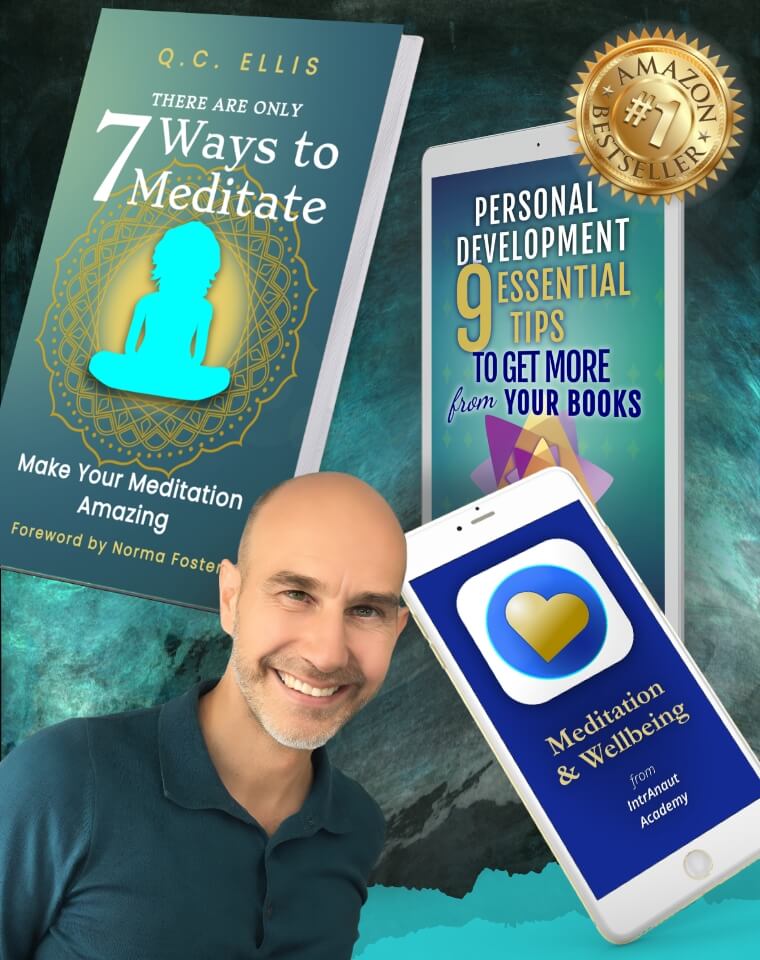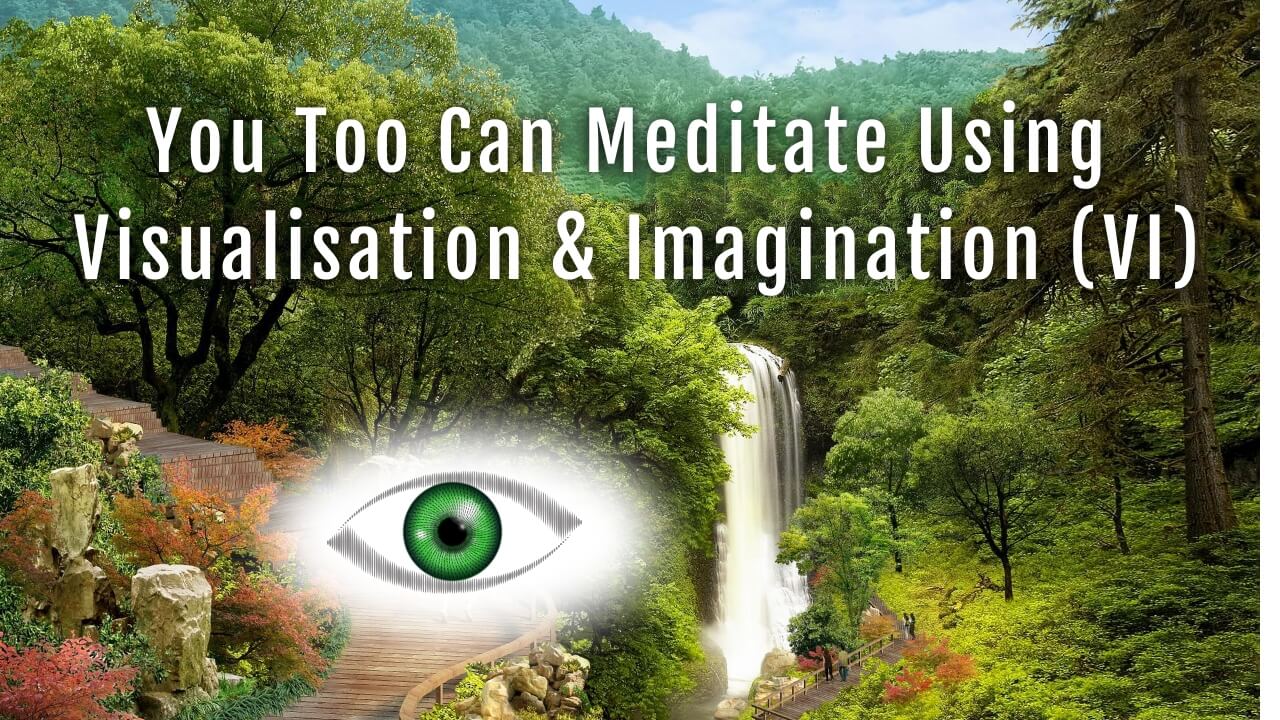An excerpt from the book, There Are Only 7 Ways to Meditate : Make Your Meditation Amazing
Within the framework presented within the book, I call the mind-technology Visualisation or Imagination (VI).
At the meditation classes I attended in the ’90s, they guided me in various visualisations. These seemed easier than trying to stop myself from getting involved with thoughts. I simply had to follow the guidance, then generate the visuals on command. I was rubbish at visualisation.
The images were so fleeting, and I was hardly conscious of their contents. It was tough, but I’d do my best to get it right. Unfortunately, my mind would dive into daydreams and distract me from the images I was supposed to be creating.
I thought, “I need more control.” Without realising it, I was again creating the perfect conditions for more headaches, more frustration, and more distracting thoughts. Thankfully, I asked for help.
But I Cannot Visualise
There are two basic problems people find with visualisation:
They think the VISUALisation needs to be a Hi-Definition, full-colour movie they play in their head. This is the easiest and quickest way to make your meditation into a headache-inducing nightmare.
They believe it needs to be visual. Nope! For most people, it is, but your Visualisation or Imagination (VI) can be on the creative side. It doesn’t need to be visual at all. There are details below about how to do it without the visual element. And before you say, “I’m not imaginative”, let’s do an experiment.
Remember a time in the past. Does a memory pop up? It could be from five minutes ago, or years. What matters is you can tell me about it (no matter how vague).
It is your creative, intuitive mind that gives you the ability to do this. I know you may have been told creativity isn’t about memory. For meditation, you do not need to have any more of a creative ability than the creation of memories. Memories are not data dumps you can access, like a DVD or static website.
Memories are re-created each time you want to access them. This is like a dynamic social media platform. These create the page (and advertising) for each person, depending upon their profile, likes, and interests.
Memories that are accessed most often are easier to recreate. Please feed your brain with all the good times.
Is there anything in your life you would like to do again? Maybe something that makes you feel amazing! Can you remember it?
- Can you envision doing that again?
- When you bring up that memory, does it bring up any feelings?
- If not immediately, can you access the feelings you had – even if subdued – if you try. Don’t push; relaxing helps.
- When imagining doing it again, is there a vague flash of an image associated with the event?
- When imagining doing it again, are there thoughts describing it?
- When thinking of doing it again, do you just know the answer? Do you have a sense of what may happen?
If you said “Yes” to any of the above, you are using the technology of Visualisation or Imagination (VI). How? Read on for an answer to each of the six ways you can use VI. These six below relate to the six just above.
- If you can contemplate doing something in the future – even without visuals or it being different to your experiences in the past – you are using VI.
- Some people have a greater connection to their ability to feel.
- Your VI could be mostly recognisable by the feelings the non-visualisation creates in you.
- For the vast majority who say they can visualise, the imagery is vague and fleeting. That is normal, and you should not try to make it clear.
- For some people, their verbal thinking is dominant, which means they describe (or sometimes see words) instead of imagery or feelings. Your descriptive thoughts are your way of imagining.
- You are using the intuitive faculty, which needs no words, feelings, or imagery. You have a sense of what is happening, and that is enough.
Everyone has all the mental abilities: visual, audio, feeling, and intuitive knowing. For most people, one is primary.
If that is not a prowess for imagery, it may seem as if you cannot visualise. However, you can still imagine (VI) through your principal ability. You can also work on allowing the other faculties to develop. Do this by noticing even the slightest glimmer and celebrating the tiniest of achievements.
Have you ever woken up from a dream because you heard a sound, then realised the sound must have been a part of your dream? Have you ever woken from a dream, and remembered a part of it? Hearing sounds within a dream is proof you can create sounds in your mind. To remember having a dream is proof you are able to imagine.
Fake It Till You Make It
There are too many wannabes faking it so they can make it in the world. Hype rules over substance. Yet, with your imagination, I fully recommend you go along with guided meditations as if you can connect with all aspects of the visualisation.
For instance, I found a particular Visualisation or Imagination (VI) meditation difficult. We were being instructed to connect with a spark of light at the heart as a direct link to the infinite Self. I couldn’t feel the connection (it just felt fake to me). But I could imagine a connection, despite it feeling fake, so I dispensed with disbelief.
When you fake it when allowing your intuitive mind to use the narrative for healing, then it can be a beneficial meditation. If you get hung up on the validity of the details, it will have no benefit.
On a basic level, by pretending you can meditate (while not deluding oneself that things that are not meditation actually are), you are facilitating your practice. For example, if focused on the breath at the nostrils, but unable to feel the sensations, you have choices. One of which is to pretend you can and see what happens.
The paradox is between pretending to meditate and the knowing what is actual meditation. Yet they can be the same. I am pretty sure a lot of my meditations have been pretend, yet I have still progressed.
Now you know visualisation doesn’t have to be clear, lasting, or even visual. Are you ready to go deeper into Visualisation or Imagination (VI)?
-
About the Author
Colin (Q.C. Ellis) has been on meditation retreats in silence and solitude for longer than some monks. He has been studying meditation for over 23 years.
Known as a meditation maverick, and creator of IntrAnaut™ Meditation, he teaches methods to awaken your body’s natural restorative abilities and fire up your inbuilt happiness.
Keeping it real and grounded in personal experience, he is a Transformation Coach, and founder of IntrAnaut™ Academy.
In person, Colin is approachable and would love to hear from you. For ways to connect, click HERE – ColinEllis.info
For additional resources, download his FREE, IntrAnaut Meditation mobile app with the QR code below or tap HERE


